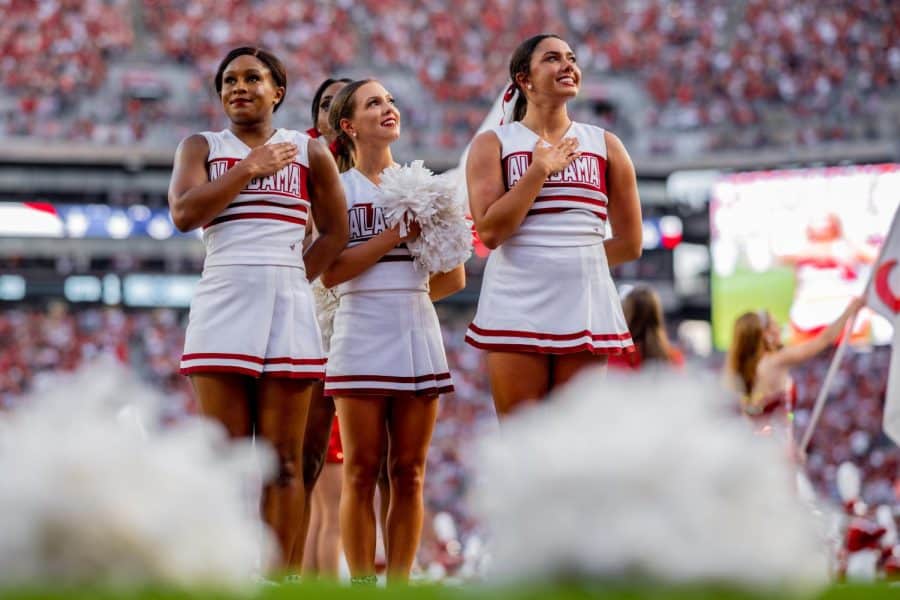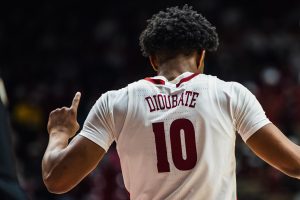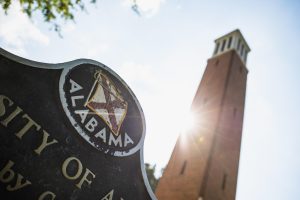Transforming the ‘look’ of UA cheer
October 20, 2022
In pop culture, the stereotype of a cheerleader is that she’s peppy. She has a large, red-lipsticked smile plastered on her face, and she’s blonde. Usually super tan as well, but always blonde. From the Cheerios in “Glee” to the majority of cheerleaders under any Friday night lights on the big screen, the culture is predominantly white.
Dallas Cowboys cheerleader Briana Baisden says that her time dancing with the Alabama spirit squads was defined by this ‘look.’
“The University of Alabama as a whole, you see most of our athletic teams like football and basketball have predominantly black players and athletes,” Baisden said. “Then you look on the sidelines and you see the opposite within the spirit squads.”
At The University of Alabama, spirit squads encompass everything from the Crimsonettes to the cheer squad to the dance team. During Baisden’s time on the dance team, she was one of the only women of color.
Baisden says that part of the problem was the intimidation factor.
“I think we can all agree that Alabama has a certain ‘look,’” Baisden said. “If you look over the past 20, 25 years of Alabama dance team, you can count on one hand, maybe two, how many Black women have been on the team. So, if you’re a freshman coming in on the team, you’re coming in and you’re looking at that, and you’re wondering ‘Is there a space for me?’”
While today’s spirit squad is still predominantly white, it includes more Black and other minority members than it did during Baisden’s time on dance team. But junior cheerleader Kristianna Morgan, majoring in nursing said, despite the accepting attitudes from her coaches and teammates, she would still feel anxiety if she wore her hair differently than the typical cheerleader ‘look,’ like in braids or naturally curly.
“I don’t think it would be a big deal if we decided to [wear braids or natural hair], like me personally, for no reason I probably would still be anxious about it or about going through with it,” Morgan said. “I don’t think I would be anxious about asking [coaches] but like actually having it, just because it is not the expectation.”
Fellow junior cheerleader Tiana Taliaferro, who is majoring in elementary education, says she had similar anxieties about not fitting the typical cheerleader look growing up.
“The gym I cheered at wasn’t predominantly white but there were times I felt like I had to be a certain way,” Taliaferro said. “During choreography, I would think they wouldn’t put me in front because I’m Black. But it wasn’t necessarily because they made me feel like that, but I believed it in the back of my mind. There were a lot of things in my head that led me to think that they wouldn’t do certain things because I was Black.”
Although the cheer culture at The University of Alabama has changed since Baisden attended, lifelong doubts still dance in the back of many spirit squad members’ minds. Years of little diversity and the preconceived notions and stereotypes surrounding cheer culture do nothing to help build confidence in these members. Former members like Baisden, though, can help crush those doubts.
“In regards to that [‘look’] and spirit squads in general, there’s a fine balance between wanting to look collegiate and Southern, the ‘wholesome, Southern Belle look’ and being exclusionary,” Baisden said. “I think having a diverse audition panel when it comes to judges is the first step in general.”
When she isn’t cheering for the Cowboys, Baisden judges Crimsonette auditions and works closely with their choreography teams. She said that when potential Crimsonettes see women who look like them in the organization, they know that there is a place for them on the team and with the UA spirit squads.
Since Baisden left the Alabama dance team after graduating from the University, the spirit squads have slowly but surely become more inclusive and diverse, in part because of a change in leadership. Baisden said she appreciates the opportunity to talk to this new generation of dancers and cheerleaders.
Taliaferro says that having Brandon Prince, who is also Black, as a cheerleading coach, has impacted her view of the ‘look’ during her time on the cheerleading squad.
“He’s not super strict with hair and makeup because he knows that a shade of lipstick on me won’t look the same on a really pale person,” Taliaferro said. “That’s one thing I really like about it, that they don’t want us all to look the exact same. They all want us to be ourselves.”
Allowing each member to develop their own look was one factor that greatly influenced Taliaferro’s decision to cheer at UA.
“When I looked at Alabama and came to clinics, I looked at how diverse it looked and how he let them do their own thing,” Taliaferro said. “Now, being on the team, it really is true.”
Morgan says that hair plays a big part in that.
“I feel like they encourage us to express ourselves through our hair,” Morgan said. “This year I had braids for headshots because it was still summer, and I did not want to have to change my hair yet and it was fine actually. It did not matter at all.”
In fact, for Morgan, the cheer squad has become a comfortable place for her despite its predominantly white history.
“It has been amazing,” Morgan said. “I don’t have to walk into practice or walk into a game like ‘Oh my gosh’ you know, like when you walk into a predominantly white room and you are like ‘wait, I am the only Black person?’ It’s not like that at all; you don’t think about it.”
UA cheer culture has come a long way since Baisden danced with the spirit squads back in 2011. It is beginning to shift from only preppy, blonde girls with bright red lipstick to a more inclusive environment that encourages every girl to bring her own look onto the squad.
“A lot of it is being able to say ‘I don’t know this, where can I be better?’ and accepting that feedback,” Baisden said. “It’s not always bad, it’s not always good — it’s just ‘How can I be better?’”
Questions or comments? Email Austin Hannon (Sports Editor) at sports@thecrimsonwhite.com





















